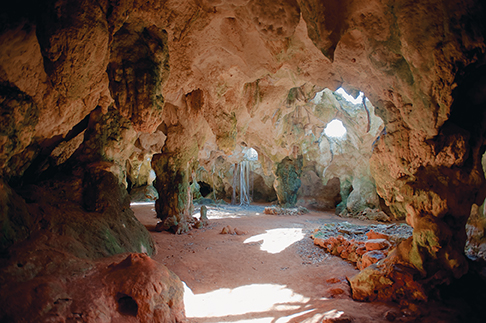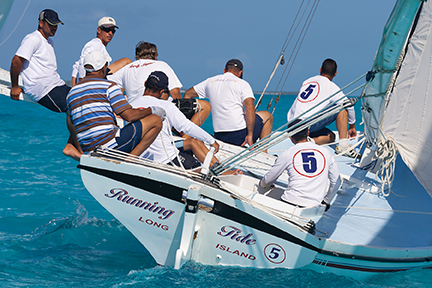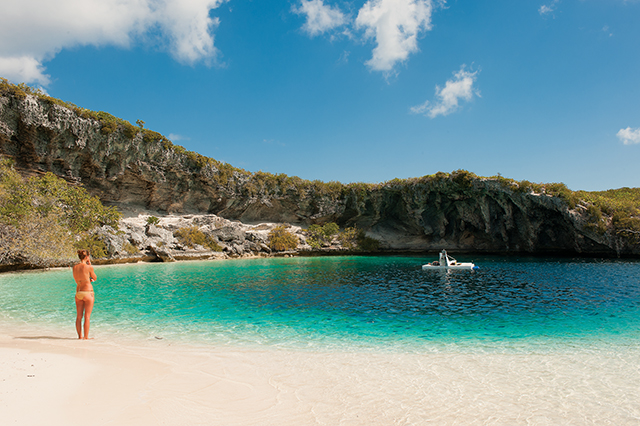Fast boats and tranquil diversity (published November 2012)
A centuries-old sailing tradition dictates that whenever multiple boats are on the water they must engage in a race. These races, however, are neither acknowledged nor declared and, if one is close enough to be seen by the opposing crew, neither the helm nor any part of the vessel involved in sail trim should be touched. It’s also considered bad form to hail the prospective opponent on VHF to comment on each other’s parentage.
These are, of course, not rules, just guidelines—guidelines under which we departed Georgetown headed for Long Island this past March. The fleet, Chris and Liz Calder on Spindrift, their Malo 40; Bruce Ray on Zingara, a Contest 35; and yours truly on Worthless Wench, my Pacifc Seacraft 40, had been having daily tussles on our way down the Exuma chain. Bruce had been working out some issues on his new vessel and Liz was content to let the boys play, so it became a battle between Chris and me. The boats were so evenly matched that whoever did a better job secretly trimming sails and hand-steering ended up getting to the anchorage first.
The voyage began as a long motoring slog with the main up, directly into the wind. Needing to charge batteries and make water, Chris and I were content to neutralize the unspoken hostilities until the turn to the final waypoint, from White Cay Bank to Indian Hole Point, which would put us on a close-hauled, 11.3 nm sprint into Thompson Bay, Long Island.
Two miles before the final leg, the wind veered to 40 degrees off the beam. As if on cue, both of us instantly had our genoas out and motors off. We were off to the races. The wind wasn’t going to make this an easy one, however. Shifting in 30- to 45-degree arcs and gusting from 10 to 25 knots, Aeolus presented a series of challenges. After a two-hour battle, Worthless Wench managed to hit the finish waypoint first.
Safely anchored in Thompson Bay, watching the sun melt into the sea with Dark and Stormies in hand, Bruce, Chris and I verbally replayed the last 12 miles, tacitly acknowledging that yes, there might have been some steering, trimming and tweaking going on—mostly due to the vagaries of the wind, of course. Liz just shook her head.
A WARM WELCOME
The following morning we discovered just how appropriate it was that we had raced to Long Island. This place is all about racing. With the National Family Islands Regatta starting in Georgetown on April 27th and the Long Island Regatta starting on June 2nd, the whole Island had Regatta Fever.

Mike McKnought-Smith moderates the cruisers’ net daily at 0830 from Long Island Breeze Resort, providing headline news, weather, one bad joke, and general information about services and events in the area. Mike, who originally hails from Brighton, England, speaks with the antipodean twang commonly heard among the professional sailboat racing crowd. He comes by this honestly, having competed in the America’s Cup, Sydney Hobart and ’79 Fastnet, among other events. On April 27th, he would be on Beerly Legal, one of Long Island’s C Class entries and New Courageous, a Class A entry from the Ragged Islands.
Mike and Jackie Higgins, managing partners of the Long Island Breeze Resort in Salt Pond, offer a cruiser-friendly atmosphere and services that include a floating dinghy dock, Internet, trash disposal, laundry and shower facilities, restaurant/bar, fresh water swimming pool and hotel rooms for times when guests have made your boat shrink to half its size. The facility, located adjacent to the new government dock, is across the street from a grocery store and 50 yards from a fuel dock. The anchorage in Thompson Bay is vast.
Jackie is the facilitator, making sure you get the best deal from local merchants. Actually, almost all Long Islanders do their best to provide exceptional service without too much urging. It’s virtually impossible to walk on the highway without someone stopping to offer you a ride. No wonder they call this “The Friendly Island.” Just remember to wipe the Long Island dirt from your face after kissing the ground following some of these rides. The island-wide 20 mph speed limit is not even a consideration, and having all four wheels on the pavement is merely an option.
For the cruiser whose anchor is not permanently mired in Georgetown sand, Long Island is an easy 35-mile sail and a great opportunity to begin extending one’s cruising grounds. Provision at Long Island and jump off to the Jumentos Cays to the south, Acklins to the east, and Conception, San Salvador or Cat Island to the north.

DEEP THOUGHTS
Long Island itself is some 80 miles long and only about four miles wide, making it easy to visit beaches on either side. The best way to see the island is to rent a car. Jackie took Mr. T, owner of Mr. T’s Car Rentals, to task on our behalf when she felt we were being charged more than the agreed-upon amount for a car rental. “I pity the fool…”
Bruce, having visited Long Island before, took charge. In two days, under his direction, the four of us saw three quarters of the island, stopped and talked to a number of people, had two delicious lunches, bought provisions, toured a number of the attractions prioritized by Mike, and ended up spending less than $50 per person for the car and fuel.
During our journey south, we spent several hours at Deans Blue Hole, at 663 feet the world’s deepest blue hole and second largest underwater cavern. Because of its location, Dean’s Blue Hole has become the home of Vertical Blue, a free diving academy run by world record holder William Trubridge and his wife, Brittany. In addition to training at this facility, the couple coaches free diving enthusiasts. Brittany also teaches yoga, a discipline essential for surviving underwater up to four minutes on one breath at lung-crushing depths of more than 400 feet.
The couple hosts an annual invitational free diving competition offering the world’s top divers the opportunity of besting personal, national and world records in the three depth disciplines away from the pressure of a world championship competition. This year’s edition attracted 18 divers from 14 nations, resulting in new national records for Chile, Serbia, Switzerland, Australia, Russia, Spain and Canada. Two world records were broken, as well.
Returning to the world of mortals, we continued south. On the way to Clarence Town it’s worth making arrangements with Leonard Cartwright to visit Hamilton’s Caves. Cartwright, who actually owns the land under which the caves are located, gives an interesting and informative hour-long tour through a series of caverns, some of which were home to Lucayan Indians 500 years ago. The four of us who made the visit negotiated a 25% price reduction for the tour, but were so impressed that we renegotiated with Mr. Cartwright to enable us to pay him his full fee.
Clarence Town, a well-protected harbor on Long Island’s east side, is home of Flying Fish Marina and anchorages offering virtually all-around protection. Clarence Town is also the home of two unique churches.

The first of these, St. Paul’s, is an Anglican Church rebuilt by Father Jerome following the 1908 hurricane that devastated part of the Bahamas. Father Jerome, who was a trained architect, built a number of churches on Cat Island as well. This was followed by a visit to Rome, during which he converted to Catholicism. On his return to Long Island he built St. Peter’s, a Catholic Church on a hill adjacent to his Anglican Church. His churches feature strong Spanish and Moorish architectural influences as well as vaulted ceilings and thick, hurricane-proof stonework.
On a more secular level, Clarence Town is also the home of Rowdy Boy’s Bar and Grill, where we had lunch and caught up with Bertis Knowles at work on Ruff Justice, his Class A entry into the Family Islands Regatta. Knowles, owner of the restaurant, comes from a family renowned for building some of the fastest Bahamian Racing Sloops. He was lamenting that, for the first time in the 58 year history of the regatta, competitors were allowed to use Dacron sails instead of the requisite cotton sails of past years, putting those not able to afford new sails at a disadvantage. By the same token, however, with a devilish gleam in his eye, he proudly showed us how he was bending the rules with design changes he made to Ruff Justice’s waterline.
THE CAROLINA OF THE CARRIBEAN?
As we drove back to Salt Pond, I began to notice just how similar Long Island is to rural North Carolina. Everywhere you look there are Bahamian Sloops of all three classes in backyards, under trees or tarps, and in workshops, sheds and garages; just like there are stock cars in similar spots in North Carolina. There’s even a community called “Pettys” on Long Island. I half expected to see King Richard with his cowboy hat, sunglasses and big smile trying to sell me some Goody’s Powder.
Just as in the early days of NASCAR, the Bahamian regattas were born of commerce—some legal, some not—with conveyances capable of transporting these goods fast enough to stay ahead of competitors and, sometimes, the law. In the North Carolina mountains it was cars; here it was sailboats.

Now, with the National Family Islands Regatta just beyond the next green flash, these boats were being repaired, tweaked, painted and brought up to racing trim. In the bars, with past races being discussed and predictions made for the upcoming championships, it’s clear why they call sailing the National Sport of the Bahamas. Based on conversations I overheard, I’d venture to guess that while they’re racing, just as in NASCAR, they’ll be bumping and grinding and “trading paint.” I’d also guess that, in the heat of battle, there’ll be no provision barring competitors from commenting on one another’s parentage.

A former professional bicycle racer who competed for the U.S. in the 1964 Olympics, Bill Kund is a commercial photographer based in Washington, NC or on his boat—wherever assignments take him. In addition to his editorial work, Bill helps shape advertising and marketing campaigns for clients in the nautical industry. To stay current, he sails Worthless Wench, his Pacific Seacraft 40, as far and often as his schedule allows.

















